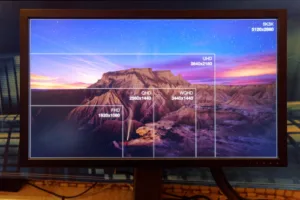I make no apology for quoting display industry veteran, Mark Fihn of Veritas & Visus, in his memorable question “What the !??XXX is a Qwuxga?”. Mark was commenting on the ridiculousness of the acronymns used by different vendors and industry pundits to describe different resolutions.

I too have railed against this habit, especially some years ago in Information Display magazine and a couple of times in Display Monitor over 20 years. (I was once quoted the term WXGA to describe three different panels by a single panel maker at SID – one was 1280 x 720, one 1366 x 768 and the final one, 1280 x 800).
Now, at CES 2015, we see, again, the ridiculously poor marketing messages that the display industry puts out to its customers.
Diagonals
I have complained for years that, effectively, the display industry gives out numbers that are the square root of the size delivered. In other words, by quoting diagonal sizes rather than, for example, area, the industry undersells itself. To someone that is not in the industry (and even to many within), it’s not obvious that by jumping from a 19″ screen (154 sq. in.) to a 24″ (246 sq. in.) brings a 60% increase in area, as 24 is only 26% bigger than 19. TV buyers simply don’t realise that a 46″ TV has more than twice the area of a 32″.
Megapixels…
Now the industry is about to shoot itself in the foot again. At CES, I saw a number of “5K” displays. How much better than “4K” (or UltraHD) are they? Well, if you asked most customers, they might guess at 25% on the basis that the number is 25% bigger. However, a “4K” is 8.3 megapixels (3840 x 2160). On the other hand, a “5K” is 5120 x 2880, which makes it 14.7 megapixels – an increase of 77%! (and I’ve even seen people that have been in the industry more years than me get this wrong.)
And there’s worse to come. “8K” displays will be developed in coming years. They will be 16 times more resolution than the “Full HD” 1920 x 1080 standard, while the industry will give consumers the idea that (compared to 1920 x 1080), they are just 4X better.
The camera industry has understood this point and has always talked about megapixels, but the only part of the display industry that has done this, as far as I know, is the medical side, where people understand 2, 3, 4 and 6 megapixel displays. In the past, I have often felt the desire to increase the megapixels in my camera, even though I knew that if they are poorly exposed, noisy, fuzzy pixels, then the experience won’t be much better. I’m still susceptible to the hype of the makers.
I see that Wikipedia is calling 5120 x 2880, UHD+. As a buyer, should I know that a + means 77% more? How much should I pay for a + on a resolution?
Surely describing these displays in ways that consumers might understand would help more to discover the joys of a truly high resolution display?
As I said in the article in Information Display magazine, it can be hard to communicate the benefits of better products and persuading customers to spend more. However, if you don’t communicate the benefits, you can be sure that you won’t get them to spend.
Bob
Viewsonic called its monitor 5K, but at least it had the pixels showing the difference!

